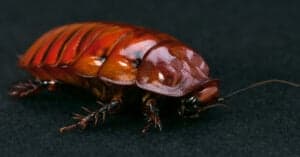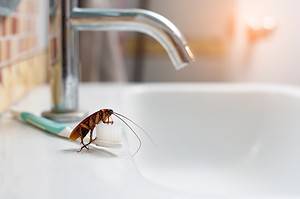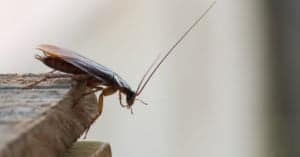Cockroaches are scavengers, but what do cockroaches eat? Omnivorous, they’ll eat almost anything they can find. This insect would certainly prefer the foods we eat but is capable of sustaining itself on a variety of non-foods. Let’s answer the question once and for all, what do cockroaches eat?
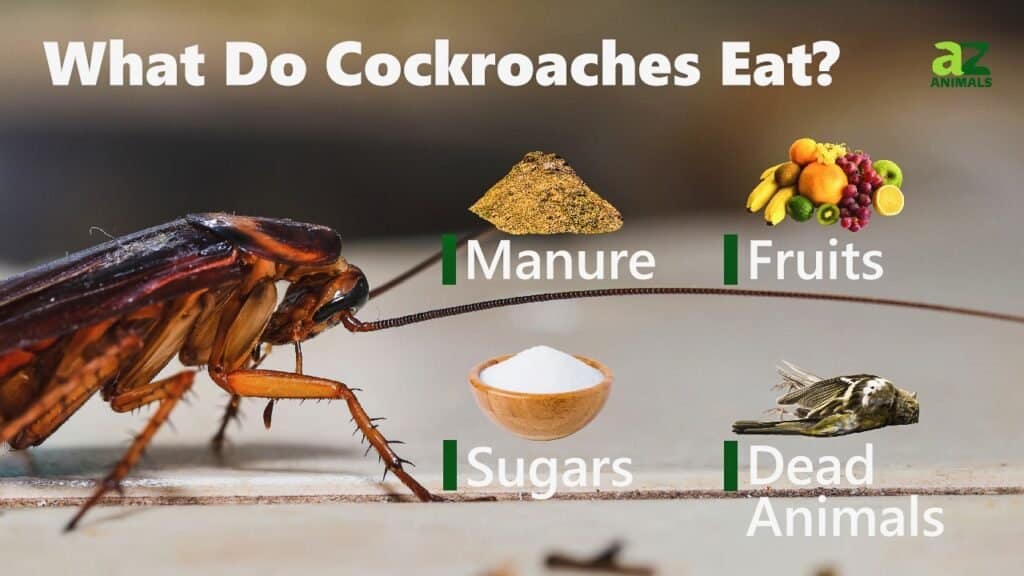
What Is a Cockroach?
The cockroach is an insect and could be among the longest living creatures in the world. They are masters at hiding, making these pests one of the hardest to get rid of. Alongside their prolific breeding, the creatures are resilient.
Some fossils imply they’ve been around for over 320 million years. They may have possibly outlasted anything that’s ever walked the earth.
The cockroach’s appearance is an oval, flattened body, threadlike antennae with a shining brown or black leather-like integument. The head’s bends down. Unlike other insects, its mouth points backward as opposed to downward or forward.
Males typically have two pairs of wings. Females, in some species, have vestigial wings. In others, they’re wingless. There are over 4,500 roach species. But only a little over two dozen live around humans.
The scavenger definitely prefers humid, warm, dark environments. They invade indoor environments, inhabit sewers, and live in dead trees. While they’re everywhere, a high portion of the population lives in tropical, mild climates.
That’s Disturbing…
Many already consider the cockroach a disturbing sight with its creepy-crawliness and threat to health. Imagine when a cockroach takes to the air? Flying roaches are in many parts of the country and are common around the world.
The hissing cockroach is another troubling sight. A disturbance, such as a light or danger, will find a hissing cockroach releasing a squealing pitch. It’s a signal of danger or warning to colony members.
Unlike their kin, hissing cockroaches have no association with diseases. They do not seem to possess worms, viruses, and bacteria. Many cultures keep them as pets.
The Cockroach Survives
The cockroach’s great capacity to survive shows in what it eats. They may prefer chowing on sweets and meats, but when that’s not available, they happily eat paper, food, clothing, books, decaying wood, and dead pests such as bedbugs.
Cockroaches need water. Without it, they perish quickly. Curiously, if they cannot get food but have access to water, the insect can survive for months.
Roaches adapt, consuming any available food. They invade kitchens, grocery stores, restaurants, and basements. They dwell behind and underneath furnishings and in wall cracks.
With the ability to climb walls and ceilings, there is no crevice they can’t access. They venture mostly in the dark. (The infamous scene of turning on a light and watching the roaches scurry is familiar to many.)
It has been joked that the cockroach can survive anything, even nuclear fallout, and will out-survive mankind. They have evolved to be very adaptable and just flat out tough to kill. Finally, the cockroach will ultimately find something to make into dinner, even in the most desolate environments.
The Cockroach Diet
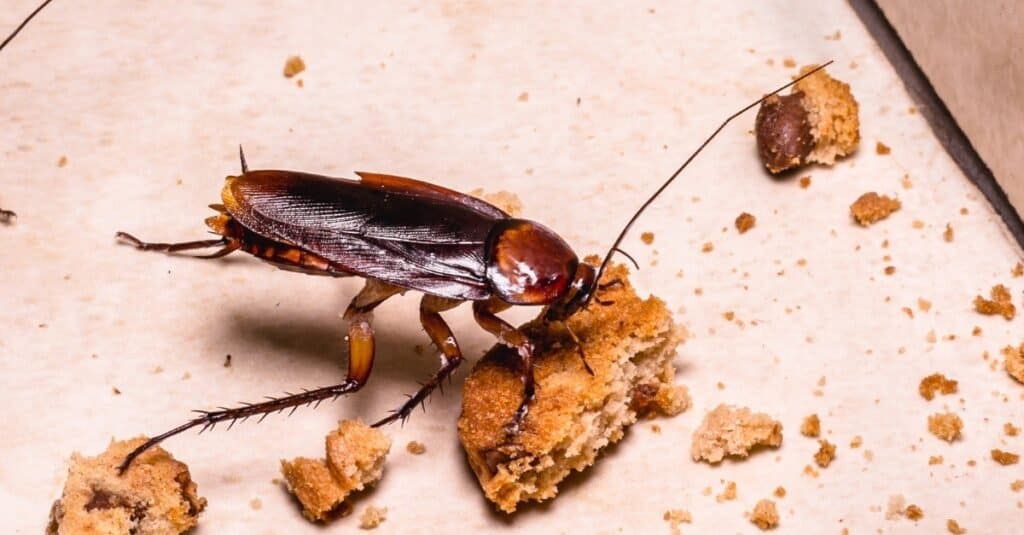
©iStock.com/RHJ
As omnivores, roaches are fine with animals and plants. But they’re not picky. They will chomp on any substance that came from a living organism.
- Starches
- Sweets
- Greasy substances
- Meat
- Bread
- Cardboard
- Books and book bindings
- Wallpaper glue
- Paper
- Cat litter
- Stamps
- Feces (including their own)
- Fingernails
- Dead skin (including their own)
- Hair
- Leather
- Plastic
- Soap
- Toothpaste
- Dead insects (including other roaches)
The omnivorous pests chew through containers. We’re talking about sugar, flour, bags of chips, and cereal boxes. Once the insect penetrates the package, consider it contaminated.
Predators
Among its many predators are toads and frogs. Mice are a common threat. Beetles, spiders, and other insects go after the cockroach. Beetle larvae and silverfish are a threat too. Other cockroaches cannibalize their cousins.
The Threat of the Cockroach

©gan chaonan/Shutterstock.com
A Cambridge study found over 30 different bacteria in these scavengers that live in proximity of humans. Cockroaches are one of the filthiest animals on the planet. The insects walk around with a variety of pathogens that influence disease.
Science hasn’t found a link between the creatures and a specific outbreak but believes they routinely spread infections. The World Health Organization calls cockroaches potential carriers of microorganisms linked to dysentery, cholera, diarrhea, and typhoid fever.
When roaches walk across your tables, kitchen counters, or — gulp! — food, there’s a possibility of transferring pathogenic microbes. As if that weren’t enough, cockroach feces release an odorous pheromone. Unless the insect populace is high, we never smell it but other roaches will. It lets the gang know there’s a good place to eat and nest. Long-term exposure to feces can promote respiratory illnesses.
How Do Cockroaches Digest What They Eat?
Cockroaches have a digestive system that symbiotically takes in bacteria. The bacteria give the omnivorous roach nutrients and help it ingest all those nasty compounds.
Science believes the roach’s millions of years surviving in the worst ecosystems and learning to diet on anything resulted in the cockroach’s uncanny ability to metabolize dangerous or toxic elements.
The roach digests cellulose. It’s why they nibble on bindings, newspapers, documents, and cardboard. Outdoor creatures enjoy piles of twigs, leaves, and dead trees.
What Can You Do About Roaches?

©Elnur/Shutterstock.com
Here’s what we can do to manage the near-impossible task of roach management.
Clean the Floor
The first step to managing cockroaches is remembering they spend a lot of time on the floor. The next thing to remember: they eat anything. That means your worst of the worst is a meal, including pet dander and skin flakes.
Roaches have an extraordinary sense of smell and use it to locate the teeniest, tiniest morsel. And the floor doesn’t have to be dirty to have dust mites or debris. Keep floors clean, especially in dark areas where roaches conceal themselves.
Pet Food
Pet lovers leave a bowl of food for their animals, especially if they’re out for the day. You may as well be setting up roaches for a Vegas vacay with an all-you-can-eat buffet.
Even after the pet empties the bowl, there’s enough residue for a cockroach family diet and all their amigos.
Natural resources like cleanliness and eliminating food sources help minimize roach populations. Traps are a good bet. Exterminators are another way to go.
Sprays and insecticides may help, but recent studies show that — much like the cockroach’s done for millions on millions of years — the insect’s gradually developing an immunity.
Up Next:
The photo featured at the top of this post is © Barnaby Chambers/Shutterstock.com
Thank you for reading! Have some feedback for us? Contact the AZ Animals editorial team.



